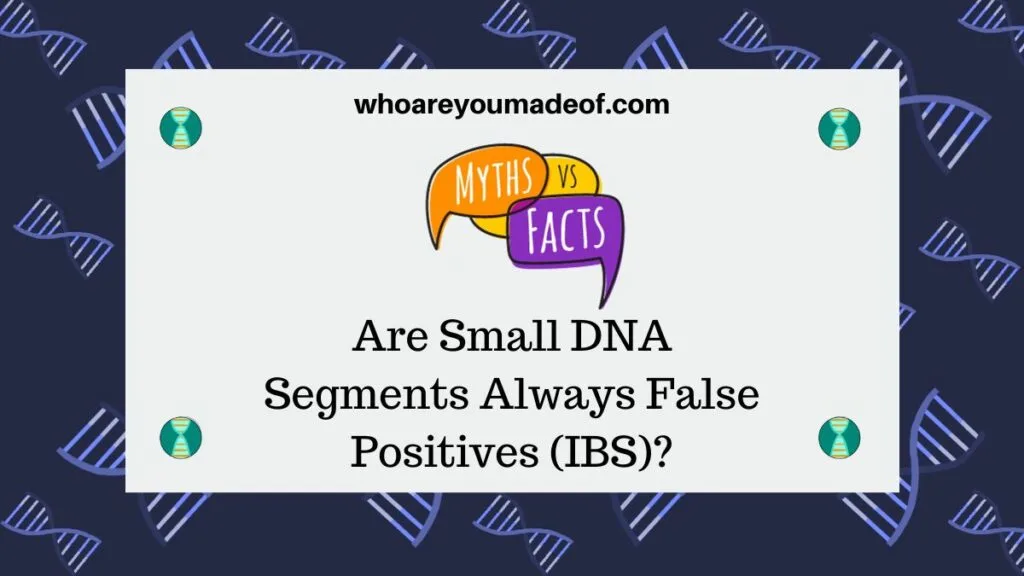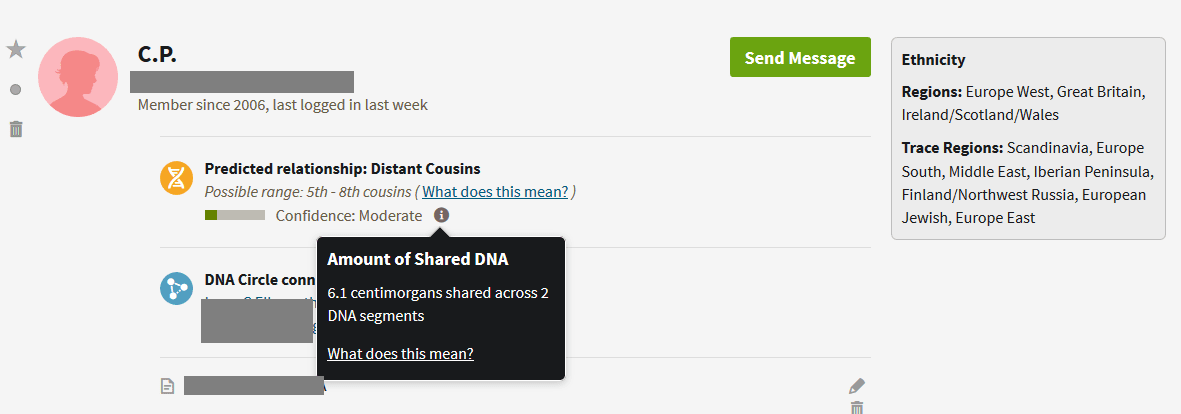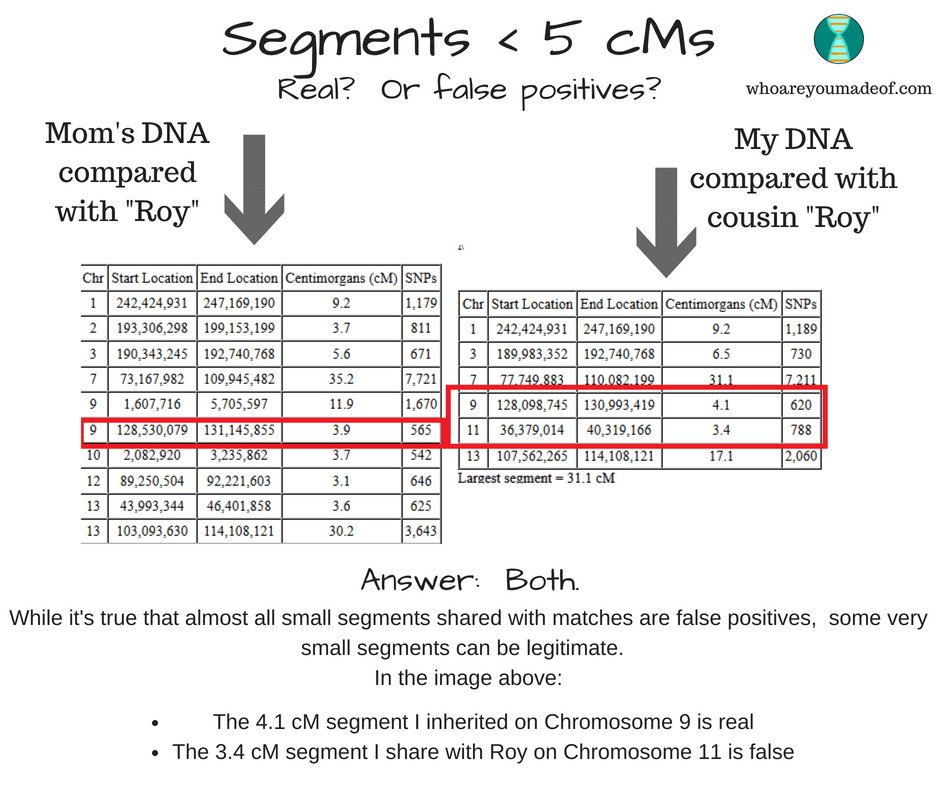When you are doing genetic genealogy, the common advice is to ignore small segments because they are almost always identical-by-state (IBS), or false positives. The key phrase is "almost always", and in this post, we'll explore segments smaller than 10 centimorgans (cMs).

You will learn:
- The probability that a small segment is a false positive, or coincidentally identical
- How to determine whether you inherited a small segment, or if it is a false positive
- How far back a common ancestor might be for a very small segment
The reason that it's important to understand small segments is because most DNA testing companies show us small segments that we share with matches. For example, Family Tree DNA will display matches that share segments as small as 4 cMs, as long as the total amount of shared DNA meets a certain threshold.
Ancestry DNA and My Heritage DNA will show you matches that share as little as about 8 centimorgans with you.
Is it a good use of time to explore these DNA matches, or will we find ourselves frustrated on a wild goose chase looking for a common ancestor who doesn't exist?
Note: If you want to learn the basics of genetic genealogy, including the basic information about DNA segments and how to access this type of information, check out my DNA Tools page. I have carefully selected the most helpful blog posts that can help you get started from the beginning.
What are the odds that a small segment is real, or inherited from a common ancestor?
As you might already know, the smaller the segment, the smaller the probability is that it is a legitimate, inherited DNA segment.
According to Tim Janzen, a pioneer of genetic genealogy, there is about a 5% chance that segments between 6-12 centimorgans in length have an ancestor that could potentially be found within about six generations. Segments smaller than 6 cMs have a less than 1% chance.
These statistics may very well be accurate, but I would like to make a few observations:
Six generations is only as far back as a 4th great-grandparents (or great-great-great-great grandparents). If we were to expand our range to 8-10 generations back, which is not unreasonable for many experienced genealogists, we could assume that the odds would be higher that a segment was inherited from an ancestor who could be identified.
Even if most segments either are false positives or are from too far back to determine which ancestor passed them down to you, there are small segments that were inherited from ancestors within the past six generations. In other words, not all small segments, even those smaller than 6 cM, are IBS, or coincidentally identical.
You can find legitimate small DNA segments in your own results
We don't share DNA with all of our relatives, and the more distant the relative, the less the probability that we share genetic material. It could also be said that the more distant the relative, the more likely it is that we only share a small DNA segment.
Beginning at third cousins, the amount of shared DNA can be as low as zero. In fact, there is about a 10% chance (depending on who you ask) that two third cousins won't share DNA. Third cousins can share as much as about 110 cMs, which means that the range of shared DNA for third cousins is 0-110 cMs.
For more distant cousins, the range gets smaller, and always starts with zero. 4th-6th cousins will share between 0-75 cMs, and most likely will share much less than 75 cMs, since at a 4th-6th relationship distance it is more likely that two people are related in more than one way, and thus could share DNA inherited from multiple common ancestors.
You can go through your DNA results and find legitimate small DNA segments - DNA segments that were passed down from a common ancestor. If you tested with Ancestry DNA, there is an easy way to do this.
Make sure that you have attached your family tree to your DNA results, and then explore your Common Ancestor Hints. Go to the last page of your hints, and check out the matches.
If you have a good family tree on the site, you might be able to find a third cousin who shares only a very small segment with you.
In the image below, you can see the amount of shared DNA that I share with this person totals 6.1 cMs across two segments. We are third cousins once-removed, however, and shared DNA between my father and grandmother confirms our relationship.

In the spirit of full disclosure, it is important to note that the only way that I could know absolutely 100% for sure that the above small DNA segments were inherited and are not coincidentally identical, even though I am 100% sure that I am genealogically related to this individual, is to view the DNA results of all parties in a chromosome browser - including the DNA from the parent from whom I might have inherited this DNA segment.
Example of IBS "Real" segment smaller than 5 cMs
Even though it's true that almost every time you find a DNA match that shares a segment less than 5 cMs with you, it will be a false positive, it's still good to keep in mind that it is possible to have legitimate small segments this size.
To demonstrate a legitimate identical-by-descent (IBD) segment and a false positive identical-by-state (IBS) segment, I'd like to show you a comparison that I ran on Gedmatch between myself and my mother's DNA with a verified, known half-second cousin.

Conclusion
I hope that this post helped answer your question about very small segments. To summarize, most are false positives - but you can still find the occasional gem that might lead to uncover the answer to a mystery.
If you have any questions about something that you have read here, or would like to share your experience with small segments (whether positive or negative), I'd love to hear from you in the comments.
Thanks for stopping by!

Doug
Sunday 9th of May 2021
Regarding common DNA segments leading to a MRCA, does it improve the likelihood of true ancestry to have more than one person leading to the same MRCA? Example: if there are 10 persons each with 7 cMs in common, is this more likely to be "real" than is there were only 1 such person? If yes, how does one quantify this? Thanks